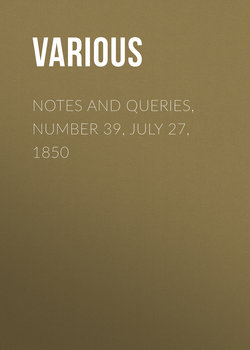Читать книгу Notes and Queries, Number 39, July 27, 1850 - Various - Страница 6
QUERIES
ОглавлениеTHE STORY OF THE THREE MEN AND THEIR BAG OF MONEY
Lord Campbell, in his Lives of the Chancellors, relates, in connection with Queen Elizabeth's Lord Keeper Ellesmere, a very common story, of which I am surprised he did not at once discern the falsehood. It is that of a widow, who having a sum of money entrusted to her by three men, which she was on no account to return except to the joint demand of the three, is afterwards artfully persuaded by one of them to give it up to him. Being afterwards sued by the other two, she is successfully defended by a young lawyer, who puts in the plea that she is not bound to give up the money at the demand of only two of the parties. In this case this ingenious gentleman is the future chancellor. The story is told of the Attorney-General Noy, and of an Italian advocate, in the notes to Rogers' Italy. It is likewise the subject of one of the smaller tales in Lane's Arabian Nights; but here I must remark, that the Eastern version is decidedly more ingenious than the later ones, inasmuch as it exculpates the keeper of the deposit from the "laches" of which in the other cases she was decidedly guilty. Three men enter a bath, and entrust their bag of money to the keeper with the usual conditions. While bathing, one feigns to go to ask for a comb (if I remember right), but in reality demands the money. The keeper properly refuses, when he calls out to his companions within, "He won't give it me." They unwittingly respond, "Give it him," and he accordingly walks off with the money. I think your readers will agree with me that the tale has suffered considerably in its progress westward.
My object in troubling you with this, is to ask whether any of your subscribers can furnish me with any other versions of this popular story, either Oriental or otherwise.
BRACKLEY.
Putney, July 17.
THE GEOMETRICAL FOOT
In several different places I have discussed the existence and length of what the mathematicians of the sixteenth century used, and those of the seventeenth talked about, under the name of the geometrical foot, of four palms and sixteen digits. (See the Philosophical Magazine from December 1841 to May 1842; the Penny Cyclopædia, "Weights and Measures," pp. 197, 198; and Arthmetical Books, &c, pp. 5-9.) Various works give a figured length of this foot, whole, or in halves, according as the page will permit; usually making it (before the shrinking of the paper is allowed for) a very little less than 9-3/4 inches English. The works in which I have as yet found it are Reisch, Margarita Philosophica, 1508; Stöffler's Elucidatio Astrolabii, 1524; Fernel's Monolosphærium, 1526; Köbel, Astrolabii Declaratio, 1552; Ramus, Geometricæ, 1621. Query. In what other works of the sixteenth, or early in the seventeenth century is this foot of palms and digits to be found, figured in length? What are their titles? What the several lengths of the foot, half foot, or palm, within the twentieth of an inch? Are the divisions into palms or digits given; and, if so, are they accurate subdivisions? Of the six names above mentioned, the three who are by far the best known are Stöffler, Fernel, and Ramus; and it so happens that their subdivisions are much
